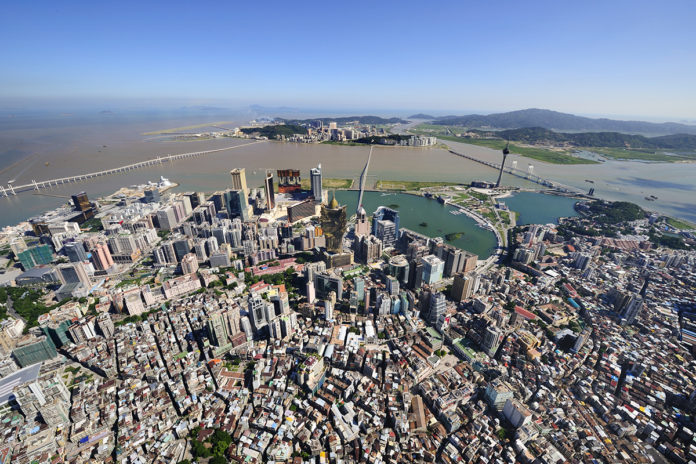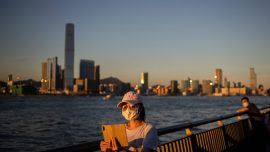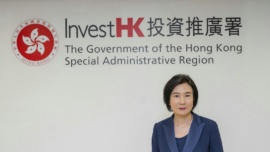Marina Bay Sands President and CEO Thomas Arasi tells Macau Business that Las Vegas Sands’ US$5.6 billion integrated resort couldn’t have been built anywhere else and describes the advantages of opening second in Singapore’s two-casino market What are you most proud of about Marina Bay Sands and how will it enhance Singapore’s attractiveness as a vacation and business travel destination? Marina Bay Sands is a unique destination offering once-in-a-lifetime experiences for leisure and business travellers. It’s the overall experience and the fact that we offer something for everyone under one roof that makes this destination so special. Where else can you find one destination with landmark architecture, the breathtaking Sands SkyPark [a rooftop pool, restaurant and lounge area 55 stories above Singapore], the best celebrity chef restaurants, Southeast Asia’s first long-running Broadway show “The Lion King”, and luxury shopping including Louis Vuitton’s first ever island shop floating on Marina Bay? [The “floating” shop is a pavilion with a glass exterior that looks like a crystal and is connected to the resort by an underwater tunnel.] Beyond the numbers and economic benefits ascribable to Singapore, Marina Bay Sands will be a very big part of creating a new mystique, inviting image and buzz in the tourism, convention and business communities across Asia and across the world. It will add to the allure of Singapore, which is already a great city. Coming attractions What’s the projected schedule for completion of the rest of the integrated resort (IR)? The first fase was opened on April 27, and this includes 963 out of 2,560 hotel rooms, part of the shopping mall and convention centre, our first three celebrity chef restaurants plus other dining options, and the casino. Our grand opening on June 23 will see us open the remaining hotel rooms, Sands SkyPark, the Event Plaza along with more great shops and restaurants. Our theatres, debuting with “The Lion King”, and the museum will open later in the year. What is the synergy between the different components of Marina Bay Sands? Is there an overriding theme to the IR? Marina Bay Sands has something for everyone and every component of our destination brings a compelling proposition that will add to that once-in-a-lifetime experience for our visitors. Whether it’s our magnificent rooftop Sands SkyPark, our celebrity chef restaurants, “The Lion King”, or our exciting nightclubs Avalon and Pangaea, each aspect of our property is nothing short of amazing. Teamwork the key What is the single biggest key to success for Marina Bay Sands? Our team members! Just recently, we saw the first groups of team members moving into Marina Bay Sands and we will see thousands more moved in at the end of April. Now, it’s our job to breathe life into that amazing building and to make it the best hotel, convention centre, casino, retail space, restaurant, theatre, and museum. Our team members – every one of us – are the heart and soul of this amazing property. What’s the dynamic of competing against another brand new world-class integrated resort across the bridge? Will there be synergy between the two IRs? Having not one but two integrated resorts will boost Singapore as a leading travel destination. Each property is unique, targeting a different customer segment, so tourists to Singapore will benefit from a greater variety of destinations and attractions. Learning curves Las Vegas Sands Chairman Sheldon Adelson said he was happy to see Resorts World Sentosa open first so you could learn from its mistakes. What has Marina Bay Sands learned? With any large scale opening or event, there will be a range of operational issues that will need to be addressed. We have been given the opportunity to understand some of the situations people face when visiting a new integrated resort in Singapore and to develop solutions to meet the requirements in the market. Was Marina Bay Sands disadvantaged in terms of hiring staff by opening second? There is a buzz created by the integrated resorts amongst job seekers in Singapore and this translates to a strong interest in jobs at Marina Bay Sands. Response for our recruitment activities has been overwhelming. Other than career fairs, our online platform and recruitment centre at Mountbatten have drawn tens of thousands of job-seekers. What about local punters? What is Marina Bay Sands doing to ensure they give your property a chance? In the coming weeks, we will launch a new and exciting loyalty program for our guests. How is Marina Bay Sands progressing with direct premium players? How much does LVS´ experience in Las Vegas and Macau help? We are leveraging the extensive network of relationships with premium players established by our teams in Las Vegas and Macau. Together with our ongoing networking events in the region, we are making significant progress in attracting premium players to our destination. Your background is hospitality rather than gaming. What advantages has your background given you for this task? What’s surprised you about this project? About working in Asia? We couldn’t build anything like Marina Bay Sands anywhere but in Singapore. In my meetings with government officials so far, I’ve been impressed by their commitment to Singapore, its people, way of life and commercial orientation, sophistication and outstanding work ethic. Few places in the world have all these attributes, which, in combination with its dynamic tourism, highly advanced group meetings industry and world-class businesses, provided the right home for Las Vegas Sands to make this incredible investment in the Singapore community. Given my love for this industry and its team members and customers, this is without question the best opportunity of my lifetime. I love the food, the style, the culture and the feel of Singapore. I feel extremely fortunate to have this opportunity to work with such fantastic team members. As icing on the cake, I love Asia, and Singapore is the best place in the region. Non-gaming component What does your selection say about the importance of the non-gaming components of Marina Bay Sands? The casino at Marina Bay Sands is only one component of our overall integrated resort and takes up less than just three percent of our total gross floor area. Visitors will come from Asia and around the world because they can have so many different experiences under one roof. Meet the new boss Thomas Arasi became the first President and CEO of Marina Bay Sands Pte Ltd in August 2009, and is overseeing every aspect of the integrated resort. Since earning a BA in Hotel and Restaurant Management from New York’s Cornell University, Arasi has spent more than two decades in hospitality operations, branding and real estate development. Prior to joining Marina Bay Sands, Arasi led three international businesses for Bass Hotels and Resorts, which does business as InterContinental Hotels, including serving as Global Brand Manager of Crowne Plaza Hotels and Resorts and as President of the group’s Americas division. He was also President and CEO of Lodgian Inc, operator of 110 hotels in the US and Canada. In real estate development, Arasi was President of Portman Holdings, a multi-billion dollar real estate developer with properties in North America, China, India and Korea, and he was President of Tishman Hotel Corp, which owns and manages large resort and convention assets. Big bay, big future Las Vegas Sands’ US$5.5 billion Marina Bay Sands in Singapore opened its doors last month, and Chairman Sheldon Adelson insists it will be the company’s most valuable property by Muhammad Cohen in Singapore Less than two years ago as Las Vegas Sands Corporation (LVS) hovered on the brink of bankruptcy, the partially built triple towers of Marina Bay Sands looked like tombstones for the company’s ambitions in Singapore. But last month’s debut of the world’s most expensive standalone casino resort, confirmed that LVS and its Asian dreams beyond Macau, may come true. “This is the future of gaming,” LVS Chairman and CEO Sheldon Adelson declared at the April 27 soft opening of the US$5.5 billion (MOP44 billion) integrated resort (IR), originally slated to debut in December last year. “The integrated resort is going to be the model for the world. There are 110 countries around the world where gaming is legalised, but it’s purely casinos. You only find a property like this here and in Las Vegas.” City landmark Marina Bay Sands (MBS) includes 2,560 hotels rooms in three towers connected by the 133,000 square foot SkyPark, with a front like a ship’s bow overlooking Singapore from a height of 57 stories that has already become a city landmark. The IR also includes an 800,000 square foot shopping mall, a 1.3 million square foot convention centre, and a 161,500 square foot casino. “Marina Bay Sands is a quantum leap from anything I’ve ever seen,” AG Leisure Partners Managing Director Sean Monaghan says. “The IR structure is amazing, and the main gaming floor is a mind blower.” The gaming floor is the most finished part of the IR, with nearly all of the 600 tables and 1,600 slot machines ready at the opening – and the most polished. The casino is spread across four levels, with a majority of the tables and machines on the first level. The upper levels form rings above, looking down on the main level, with a ceiling rising 40 metres, more than 10 stories, and topped with a chandelier with 132,000 Swarovski crystals and 66,000 LEDs. “When you walk onto that main gaming floor, there’s a presence,” Monaghan observes. “People were just standing there, looking at the design.” Lion King coming In its first phase, MBS has opened 963 hotel rooms, 35 shops of a planned 300, and more than 60 percent of its convention space. The SkyPark and remainder of the hotel rooms will open in June. Other components, including a resident production of The Lion King and a lotus-shaped museum, will open later this year, with final completion expected in early 2011. Adelson expects MBS “will be our most valuable” single property and that the IR will earn back its investment within five years, compared with a claimed four year payback on the US$2.4 billion Venetian Macao LVS opened three years ago. According to LVS President Michael Leven, a 20 percent return on its MBS investment would mean annual profits of US$1.75 billion. He adds that a 20 percent return on the company’s US$2.1 billion equity investment – the remaining US$3.6 billion is financed by debt – would mean profits of US$450 million. Category killer When fully opened, the property will attract 70,000 to 80,000 daily visitors, MBS President and CEO Thomas Arasi says, expressing particular optimism about MICE. “This property is a category killer,” he says. “We are going to blow away the meeting planner community.” He believes MICE could eventually comprise 50 percent of the total revenue at the IR. “In the initial going, I think most of the revenue will come from the [gaming] tables,” Leven predicts. In Las Vegas, gaming accounts for less than 40 percent of total revenue, while in Macau, gaming brings in more than 80 percent of profits. “It will take a while for non-gaming to generate profits,” University of Nevada, Reno Institute for the Study of Gambling and Commercial Gaming Director William Eadington observes. “Singapore will probably be closer to Macau’s non-gaming revenue percentages at first. So the VIP segment will be critical.” Singapore’s tax structure favours premium play, taxing it at just 12 percent, compared with 22 percent for mass play – in Macau, all gaming revenue is taxed at 38 or 39 percent. Government restrictions But, conversely, the premium market is constrained by the Singapore government’s restrictions. Stringent licensing regulations for junket operators include extensive financial disclosure requirements. Casino operators are also required to inform the government in advance, of the arrival of junket customers and disclose benefits given to them. “We never expected to have Macau style junket operators here,” Leven comments. “We intend to run this business without junket operators, as we do in Las Vegas. Assuming our process works, it will be more profitable.” Singapore’s government also restricts the local market: Singapore citizens and permanent residents must pay a government levy of S$100 (MOP584) per visit or S$2,000 per year to enter each casino. Leven says the company will not release estimates on the size and scope of the Singapore market for gaming and the other IR components. “If you want projections, look at what the analysts have written,” he says. However, analysts’ projections of Singapore’s gaming market run from a low of US$2.1 billion up to US$5 billion. “When I ask them where they’re getting their estimates, they can’t tell me,” Leven offers. Quality counts Singapore’s first IR, Genting Group’s Resorts World Sentosa, opened in February, but there have been no official figures released on its gaming revenue. AG Leisure Partners’ Monaghan estimates Resorts World’s daily revenue at US$2 to US$3 million per day. For the two IRs, Monaghan projects a combined annual gaming market of US$2.1 to US$2.3 billion, and he expects MBS will win 60 percent of the overall market. “I think Genting will face significant challenges going forward particularly when MBS completes their resort and ramps up their marketing,” Monaghan says adding, “Big punters tend to go high quality facilities.” A veteran regional casino executive in Singapore who asked not to be identified disputes whether the gaming market will double with the opening of MBS. “The only scenario will be cannibalisation, especially on the key revenue stream – the casinos,” he notes. Posting on Professional Ground blog as ‘Expert IR’, this executive predicts that a 60 percent market share will be crucial for survival, and tipped MBS to win the lion’s share of the market. “We hope Resorts World does well,” Adelson said of his local rival. “Our success doesn’t depend on their failure and their success doesn’t depend on our failure. I think we should work together to bring better quality and quantity of people to Singapore.” Key markets for MBS begin with its home turf Singapore, followed in importance by neighbouring Malaysia and Indonesia, according to Leven. The next level includes the rest of Southeast Asia, India, and Hong Kong. “We are not targeting mainland China,” Leven points out.
—
























